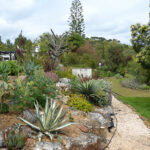In this series, archaeologist Ricardo Soares from the Vila do Bispo museum narrates the history of this fascinating region.
The history of the earth … the first stone
Around 540–200 million years ago, the current continents were united in a single supercontinent called Pangea. Right at the heart of that continent was the Iberian Peninsula. Today, in the municipality of Vila do Bispo, we can find rocks that document the earth’s three most important geological ages.
The oldest rocks belong to the Carbonic Period of the Palaeozoic Era. During the Triassic Period, at the beginning of the Mesozoic Era, a long period of erosion formed the mountains in Pangea. The lower land was covered by sediments of desert origins, forming reddish sandstone deposits. We can see outcrops of this red sandstone in the landscapes of Vila do Bispo, known locally as pedra farinheira (floury stone) and regionally as grés de Silves (Silves’s sandstones). In fact, we used this colour for the exterior walls of our museum.
Later, during the Jurassic Period, the continents began to drift. The Atlantic Ocean opened up, and the Iberian Peninsula took on its current configuration at the epicentre of the continent’s displacement. The rocks that we find today to the south of the region, between Telheiro beach and Burgau beach, are the geological testimonies of the Mesozoic and Cenozoic eras.

A geo-monument
Located on the west coast of Sagres, the geo-monument of Ponta do Telheiro is considered to be a site of international importance, as it documents the existence of Pangea. At its base, it has sub-vertical strata of shales and greywacke (a variety of sandstone that resulted from folding) overlain by horizontal strata formed by red sandstones that continue to the other shore of the Atlantic in North America! This phenomenon is known as “angular discordance”. Between these different strata, there is a gap of 55 million years, a geological discontinuity resulting from erosive processes.

The time of the giants
Vila do Bispo’s geological landscapes preserve abundant traces of living beings that have long been extinct. At Salema beach in Budens, we can see a trail of dinosaur footprints from around 125 million years ago. The footprints were originally produced in the sediments of a lagoon at a time when the local climate and landscape were quite different from today. In that environment, a mostly bipedal herbivorous dinosaur (iguanodontid ornithopod) moved slowly, leaving its large footprints, characterised by three short, wide toes. Over time, the mud petrified, transforming the footprints into ichnofossils, which were preserved in biocalcarenite rock.
On Mareta beach in Sagres, we can find tracks of ancient invertebrates of the Zoophycus type. These animals lived on the seabed, digging spiral tunnels to obtain food. In the same place, we found a large, whitish-coloured rock known as pedra do sal (salt rock). It is a fossilised coral reef preserved in its original location and position. The climate was warm and the waters were crystal clear, calm and shallow.
Chicxulub
Around 65 million years ago, planet Earth suffered the impact of a giant asteroid known as Chicxulub. The collision occurred in Mesoamerica (the modern-day countries of northern Costa Rica, Nicaragua, Honduras, El Salvador, Guatemala, Belize, and central to southern Mexico), giving rise to the current Gulf of Mexico. A catastrophic event caused the mass extinction of several species of plants and animals, including the great dinosaurs.

Dragons and living fossils
Dragons are mythological figures imagined from the fossils of the great dinosaurs. We can still find them on the coat of arms of the Vila do Bispo municipality! Our Mediterranean temporary ponds in the region are home to a Jurassic animal: the incredible Triops vicentinus, a resilient species of freshwater crustacean tadpole shrimp. It is endemic to Portugal and only found within the Faro District. It diverged from Triops cancriformis about 180 million years ago during the Middle Jurassic Epoch.
“Then, where the sidereal light declines, the Kinetic Cape, the extreme point of rich Europe, rises high and enters the salty waters of the Ocean populated with monsters.”
Avieno,Ora marítima, 201–205 (texto do séc. IV d.C. baseado num périplo do séc. VI a.C.)
Museu de Vila do Bispo – Celeiro da História
Bairro do, Sítio das Eiras, 8650-405 Vila do Bispo
Main image: Megalodon tooth © Ricardo Soares, 2024













